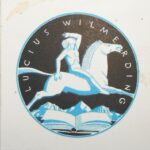[Catherine Durand Bedacier]. Les Belles Grecques, ou l’Histoire des plus fameuses courtisanes de la Grèce. Et Dialogues nouveaux des galantes modernes. Volume orné de Figures en taille douce. Augmenté de deux Pieces de Poësies du même Auteur. Paris, Pierre Prault, 1713. In-12. [12], 356 pp. ; 4 pp. of the bookseller’s catalogue. 4 engravings out of text by Crépy. [Bound afterwards, by the same author] La Vengeance contre soy-même, et le Chat amoureux. Contes en vers, par M. D***. No place, no name, 1712. 24 pp. with [2] pp. of errata. Contemporary full marbled fawn basane, spine with 5 richly decorated bands, lion of the coat of arms at the tail, tittle piece in fawn morocco, gilt arms on the boards surmounted by a supra-libris, gilt roulette on the edges, red edges.
New edition of the Belles Grecques published in 1712, augmented by the two pieces of poetry in the original edition, with their own title page.
Caroline Durand Bédacier, a novelist who died in Paris in 1736, left several works “that are not lacking in interest”, according to Hoefer. The “most famous courtesans of Greece” are Rhodope, Aspasie, Laïs and Lamia, illustrated with engravings by Jean Crépy (1660-1739), a draughtsman, engraver, publisher and print merchant. The son of a Parisian master roaster, he engraved and published images (games, maps, portraits) from 1694 at the latest. Leblanc attributes 35 plates to him. He retired on the death of his wife Marie-Vincente-Renée Chartier (April 1731) and sold part of his collection to his two sons Louis (169.-1760) and Étienne-Louis (after 1706 – after 1759). (Benezit, tome III, p. 268). La Vengeance contre soy-même is taken from the Cent Nouvelles Nouvelles, and Le Chat amoureux is a charming moral tale about the unfortunate consequences of gallantry.
With the arms of Jeanne-Baptiste d’Albert de Luynes, countess of Verrue (1670-1736) and the supra-libris of Jean-Baptiste Glucq, seigneur de Saint-Port (1674-1748). Handwritten library mark on the inside back cover “Romans 237 & ch.”.
The Countess of Verrue was famous for her love affairs, notably with the Duke of Savoy, who Louis XIV encouraged her to become his mistress. She eventually fled Savoy with her two brothers to take refuge in her aunt’s convent on rue du Cherche-Midi. Then, after living as a recluse for more than three years at her husband’s request, “the eccentric Countess of Verrue reappeared in the world and fell in love with a newly-arrived baron, Jean-Baptiste Glucq called de Saint Port, powerfully enriched at the Gobelins” says Saint-Simon, who suggests that she married him secretly, which has never been proven. He refers to him in these terms: “Saint-Port, who is very skilful in business, is the governor of the house and the conductor of affairs. He even understands intrigue and the world. So, here is a gallant with many hands, and with that king at Mme de Verrue’s, distinguished and fêted company at the Duke’s and his mother’s, with the confidence of the whole household which he and Mme de Verrue often had to mend during Mme de Prie’s time. He is a gentle, modest and respectful man who never leaves his position”. Every year, when the court was in Fontainebleau, it stayed at the Château de Sainte-Assise, which Glucq owned in Seine-Port.
Nicknamed the “Dame de Volupté”, “one of the most ravishing pearls of this splendid eighteenth-century jewel box” according to Guigard, she inspired Alexandre Dumas La Dame de Volupté: mémoires de Jeanne d’Albert de Luynes, Comtesse de Verrue, published in 1863, as well as Jacques Tournier, whose 1984 novel, Jeanne de Luynes, comtesse de Verue, was adapted for the screen by Axel Corti in 1990 under the title La Putain du roi (The King’s Whore) starring Valeria Golino (the Countess de Verrue) and Timothy Dalton (the Duke of Savoy).
From the libraries of Lucius Wilmerding (1879-1949) and N. Harwich, with their engraved bookplates. Lucius WILMERDING (1879-1949) was president of the Grolier Club from 1928 to 1932. His library was sold by his heirs at three successive sales in New York on 27-29 November 1950, 5-7 March 1951 and 29 October 1951.
Barbier, Anonymes, I, 1661 ; J. Guigard, Armorial, I, 206-207.
Binding restored. The binder has interchanged the engravings of Rhodope and Aspasia.
Spicy provenance.
2 200 €








